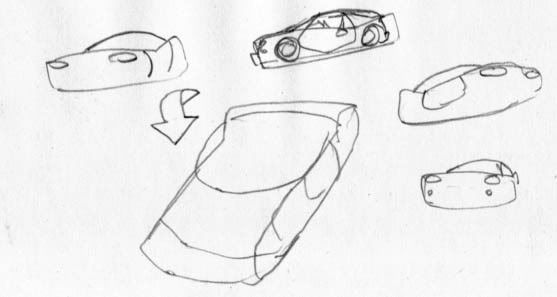
Panda!!! to be colored soon...

I was playing around with shapes, and found this nifty shape right here. This was the proverbial lightning bolt. The shape is an exaggerated assempbly of the two parts of a car that I personally need to draw it easily. The body/wheels, and the hood/windows. At this point, we're pretty much done, but that's only if you live in my head, so lets move on to the next visual step.

I have to share a drawing philosophy here. For me, the single most important tool in drawing is visualization. That first shape is the key that unlocks car visualization in my head. In order to break down that barrier between all of the distractions of reality, and that imaginary car that doesn't exist yet, I need to get SOMEthing on the page. Not only does the first shape serve as something for visualization, but it is ample construction information, if you know the parts of a car.
I learned the parts of a car from playing too many racing/free roaming games. Now I can tell myself that it wasn't a complete waste of time!
Step by step, the process in drawings two and three are perspective(lights, face and windsheld) and then information. The information is where you either need mental or physical reference to be accurate. The key things here are inventory, proportion and most importantly, silhouette.
Just to show how that shape translates to all angles, I'll turn it a few times. Here are some basic yet effective examples.

Using this method, a quick car sketch takes at maximum, thirty seconds, and at minimum, about 7. Once I found this, a drew probably about fifty cars in the next couple of days to make sure I wasn't wrong about this new method, and it checked out with every conceivable shape, style, angle and amount of reference used.
Speaking of reference, I have to cap this off by saying that for pages, I'd always use reference whether a model sheet I created, or photos of actual cars before submitting a page. Also, while this method allows for a loose and free approximation of a finished image, proper perspective and templates are still necessary for art that I'd consider finished and professional.
For all that were curious, I hope this helps.
Nelson
